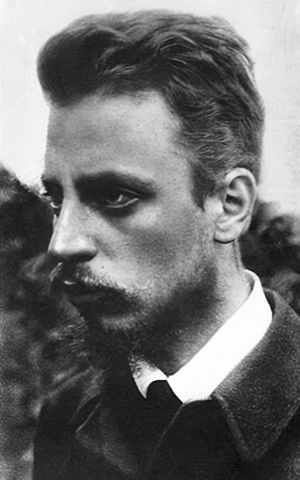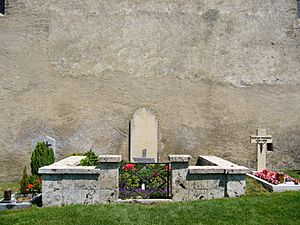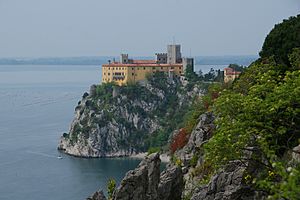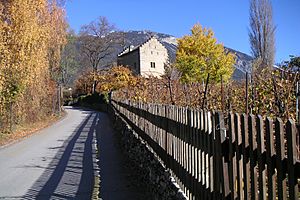Rainer Maria Rilke facts for kids
Quick facts for kids
Rainer Maria Rilke
|
|
|---|---|

Rilke in 1900
|
|
| Born | René Karl Wilhelm Johann Josef Maria Rilke 4 December 1875 Prague, Bohemia, Austria-Hungary |
| Died | 29 December 1926 (aged 51) Montreux, Vaud, Switzerland |
| Occupation | Poet, novelist |
| Language | German, French |
| Nationality | Austrian |
| Period | 1894–1925 |
| Literary movement | Modernism |
| Spouse | |
| Children | 1 |
| Signature | |
Rainer Maria Rilke (born René Karl Wilhelm Johann Josef Maria Rilke, December 4, 1875 – December 29, 1926) was an Austrian poet and novelist. He is known as one of the most important writers in the German language. His works often explore deep ideas about life, feelings, and sometimes a sense of mystery.
Rilke traveled a lot around Europe before settling in Switzerland. Many of his poems were inspired by his travels. Even though he is famous for his German writings, he also wrote in French. Some of his most well-known works in English include the poetry collections Duino Elegies and Sonnets to Orpheus. He also wrote a novel called The Notebooks of Malte Laurids Brigge and a collection of letters, Letters to a Young Poet. In recent times, his work has become popular again, appearing in self-help books and even in TV shows and movies.
Biography
Rilke's Early Life (1875–1896)
Rainer Maria Rilke was born René Karl Wilhelm Johann Josef Maria Rilke in Prague. At that time, Prague was the capital of Bohemia, part of Austria-Hungary. Today, it is the capital of the Czech Republic. His childhood was not always easy. His father, Josef Rilke, worked as a railway official. His mother, Sophie Entz, came from a wealthy family.
Rilke's mother had lost a baby daughter before he was born. Because of this, she sometimes treated Rilke as if he were a girl, making him wear "fine clothes." His parents' marriage ended in 1884.
When he was young, Rilke showed talent in poetry and art. His parents sent him to a military academy in Sankt Pölten when he was 11. He stayed there from 1886 to 1891 but left because he got sick. After that, he went to a trade school in Linz. He was expelled in 1892 and returned to Prague. For three years, he studied to pass his university entrance exam, which he did in 1895. Until 1896, he took classes in literature, art history, and philosophy in Prague and Munich.
Meeting Lou Andreas-Salomé and Travels
In 1897, Rilke met Lou Andreas-Salomé in Munich. She was a well-traveled and smart writer. She suggested he change his first name from "René" to "Rainer," thinking it sounded more strong and German. Their relationship lasted until 1900, and they traveled to Russia twice. Even after they separated, Lou remained a very important friend to Rilke throughout his life. She later studied psychoanalysis (a type of therapy) with Sigmund Freud and shared her knowledge with Rilke.
In 1898, Rilke traveled to Italy. The next year, he went to Moscow with Lou and her husband, where he met the famous writer Leo Tolstoy. In 1900, he went to Russia again with just Lou. They visited Moscow and Saint Petersburg, where he met the family of Boris Pasternak. The cultures of Bohemia and Russia greatly influenced Rilke's poetry.
In 1900, Rilke stayed at an artists' community in Worpswede. There, he met the sculptor Clara Westhoff. He married her the next year, and their daughter, Ruth, was born in December 1901.
Life in Paris (1902–1910)

In 1902, Rilke moved to Paris to write about the sculptor Auguste Rodin. His wife, Clara, later joined him there, leaving their daughter with her parents. Rilke and Clara remained married but lived separately for most of their lives.
At first, Rilke found Paris difficult, and he wrote about this experience in his novel, The Notebooks of Malte Laurids Brigge. However, being in Paris also inspired him. He became very interested in Rodin's sculptures and the paintings of Paul Cézanne. For a while, Rilke even worked as Rodin's secretary. Rodin taught him to observe things very closely. This changed Rilke's writing style, making it more focused and detailed. This new style can be seen in his New Poems. Paris became Rilke's main home during these years.
His most important works from this time include New Poems (1907), Another Part of the New Poems (1908), two "Requiem" poems (1909), and his novel The Notebooks of Malte Laurids Brigge, which he finished in 1910.
Duino Castle and World War I (1911–1919)
From late 1911 to mid-1912, Rilke stayed at Duino Castle in Italy, hosted by Princess Marie of Thurn und Taxis. It was there, in 1912, that he started writing his famous poem series, the Duino Elegies. However, he struggled to finish them for a long time.
When World War I began, Rilke was in Germany and could not go back to Paris. He spent most of the war in Munich. In 1916, he was called to serve in the military in Vienna. Friends helped him get a less dangerous job, and he was released from the military in June 1916. This experience, which reminded him of his difficult time at military school, made it very hard for him to write poetry.
Switzerland and Muzot (1919–1926)
In 1919, Rilke moved to Switzerland to escape the chaos after the war and to work on his Duino Elegies again. He found a permanent home in 1921 at the Château de Muzot in Veyras. In February 1922, Rilke had a burst of creativity and finished the Duino Elegies in just a few weeks. Around the same time, he also quickly wrote both parts of his poem series Sonnets to Orpheus. These two works are often seen as the highlights of Rilke's writing. In May 1922, Rilke's supporter, Werner Reinhart, bought and fixed up Muzot so Rilke could live there for free.
During this time, Rilke's health began to decline. From 1923 onwards, he spent a lot of time in a hospital near Montreux. Even with his illness, he wrote many important poems between 1923 and 1926, and also a lot of poetry in French. His book of French poems, Vergers, was published in 1926.
Death and Burial

Shortly before he died, Rilke was diagnosed with leukemia, a type of cancer. He suffered from sores in his mouth and pain in his stomach. He passed away on December 29, 1926, in a hospital in Switzerland. He was buried on January 2, 1927, in the cemetery in Raron, Switzerland.
Rilke chose his own poem for his gravestone:
Rose, oh reiner Widerspruch, Lust,
Niemandes Schlaf zu sein unter soviel
Lidern.
Rose, o pure contradiction, desire
to be no one's sleep beneath so many
lids.
There is a story that Rilke died after pricking his hand on a rose thorn while picking roses for a visitor. The small wound did not heal and became worse, leading to his death.
Rilke's Writings
The Book of Hours
Rilke's three poetry collections that make up The Book of Hours (Das Stunden-Buch) were published in 1905. These poems explore the search for God and the meaning of prayer. They use ideas from Saint Francis and Rilke's observations of Orthodox Christian traditions he saw during his travels in Russia.
The Notebooks of Malte Laurids Brigge
Rilke wrote his only novel, The Notebooks of Malte Laurids Brigge, while living in Paris. He finished it in 1910. The book is like a diary filled with poetic language. It includes stories, a description of death from illness, and thoughts about childhood and how people sometimes hide their true selves.
This novel uses a style called Expressionism, which became popular in European art and writing in the early 1900s. Rilke explored big questions about being an individual and the meaning of death. He was influenced by other writers and artists like Paul Cézanne and Auguste Rodin. He used these ideas to show how people felt worried and disconnected in a world that was becoming more scientific and industrial.
Duino Elegies
Rilke started writing the Duino Elegies in 1912 while staying at Duino Castle in Italy. For ten years, the poems remained unfinished because Rilke often felt very sad and struggled to write. This was partly due to World War I and his time in the military.
After the war, in February 1922, Rilke suddenly felt inspired again. He wrote very quickly and finished the collection while staying at Château de Muzot in Switzerland. After they were published, the Duino Elegies quickly became known as Rilke's most important work.
The Duino Elegies are deep, spiritual poems that explore beauty and human suffering. They use many symbols, especially angels, but not in a typical Christian way. Rilke begins the first elegy by asking, "Who, if I cried out, would hear me among the hierarchies of angels?" He also famously says that "every angel is terrifying." Even though they are called "elegies" (which usually means sad poems), many parts are full of positive energy. These poems are seen as Rilke's way of dealing with big questions about human life, loneliness, the perfection of angels, life and death, love, and the role of a poet.
Sonnets to Orpheus
Rilke was inspired to write the Sonnets to Orpheus after hearing about the death of Wera Knoop, a friend of his daughter. In 1922, he completed the first part of 26 sonnets in just a few days. After finishing the Duino Elegies, he returned to the Sonnets and completed the second part of 29 sonnets in less than two weeks. Wera is mentioned often in the Sonnets, sometimes directly and sometimes as a "dancer" or the mythical Eurydice.
The sonnets are full of metaphors, which are comparisons that don't use "like" or "as." The character of Orpheus, a god with a lyre (a musical instrument), appears many times. Other mythical characters and biblical references are also included. The poems also explore themes like animals, different cultures, time, and death.
Letters to a Young Poet
In 1929, a writer named Franz Xaver Kappus published ten letters that Rilke had written to him. Kappus was a 19-year-old military cadet who was unsure if he should be a military officer or a poet. He wrote to Rilke asking for advice on his poetry.
Rilke did not comment on Kappus's poems directly. Instead, he advised Kappus on how a poet should feel, love, and seek truth by understanding the world around them and engaging with art. These letters give us a look into Rilke's ideas and how he worked. They were written during an important time in Rilke's early career, when he was becoming known as a poet.
Rilke's Style and Themes
Rilke often used metaphors, comparisons, and even contradictions in his poems and writings. He explored ideas about doubt and a crisis of faith. Characters from Greek myths, like Apollo, Hermes, and Orpheus, appear often in his poems. He gave them new meanings, often using them to represent his own experiences. Rilke's poems also feature angels, which he famously described in the Duino Elegies as "terrifying." He sometimes wrote about his struggles with his Catholic faith, even depicting Mary Magdalene as the mother of Jesus' child in one early poem.
Rilke's Legacy
Rilke is one of the most popular poets in the United States. In popular culture, his words are often quoted in TV shows, movies, and music, especially when talking about love or angels. His work is often called "mystical," and self-help authors have used his words to suggest ways to live a more fulfilling life.
Rilke's writing has influenced many other poets and writers, including William H. Gass, Galway Kinnell, and W. H. Auden. Auden, a British poet, was greatly influenced by Rilke and often used the idea of angels in his own work.
Works
Poetry Collections
- Leben und Lieder (Life and Songs) (1894)
- Larenopfer (Offerings to the Lares) (1895)
- Traumgekrönt (Dream-Crowned) (1897)
- Advent (1898)
- Das Stunden-Buch (The Book of Hours)
- Das Buch vom mönchischen Leben (The Book of Monastic Life) (1899)
- Das Buch von der Pilgerschaft (The Book of Pilgrimage) (1901)
- Das Buch von der Armut und vom Tode (The Book of Poverty and Death) (1903)
- Das Buch der Bilder (The Book of Images) (4 parts, 1902–1906)
- Neue Gedichte (New Poems) (1907)
- Duineser Elegien (Duino Elegies) (1922)
- Sonette an Orpheus (Sonnets to Orpheus) (1922)
Prose Collections
- Geschichten vom Lieben Gott (Stories of God) (Collection of tales, 1900)
- Auguste Rodin (1903)
- Die Weise von Liebe und Tod des Cornets Christoph Rilke (The Lay of the Love and Death of Cornet Christoph Rilke) (Lyric story, 1906)
- Die Aufzeichnungen des Malte Laurids Brigge (The Notebooks of Malte Laurids Brigge) (Novel, 1910)
Letters
- Letters to a Young Poet (1929, published after his death)
- The Dark Interval – Letters for the Grieving Heart, edited and translated by Ulrich C. Baer (New York: Random House, 2018).
Images for kids
-
A portrait of Rilke painted two years after his death by Leonid Pasternak
See also
 In Spanish: Rainer Maria Rilke para niños
In Spanish: Rainer Maria Rilke para niños
- Baladine Klossowska
- Rainer Maria Rilke Foundation in Sierre, Switzerland






